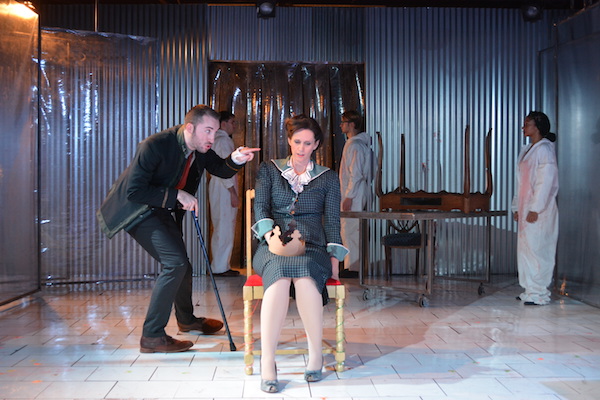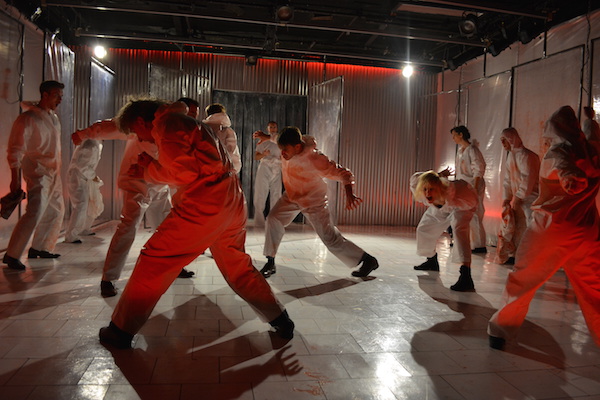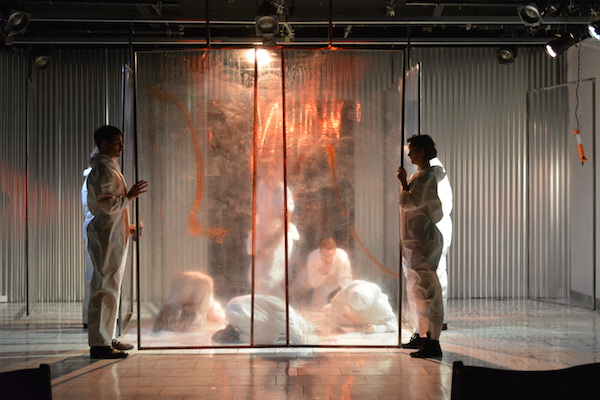
BY TRAV S.D. | Step by step, a thuggish strong man takes the people around him by surprise and seizes a country through a ruthless campaign of evil and revenge. No, I’m not talking about the latest news headlines, although I could be. I am referring of course to the plot of Shakespeare’s “Richard III” — now being presented in a “bold and bloody” manner at the 4th Street Theatre through Nov. 27.
This is the inaugural full-scale production of The Bridge Production Group (not to be confused with the Bridge Theatre Company, which was founded in 2004). The new company announces in their mission statement that they are “committed to dismantling and exploiting an audience’s expectations of mundane theatre.” While it is by no means a given that New York audiences expect theatre to be mundane, there is nothing timid about the company’s ambition. Not only does Artistic Director Max Hunter direct the current production, but he plays Richard as well. Associate Artistic Director Jacob Owen plays both Clarence and Buckingham.
“We call ourselves Bridge,” said Hunter, “because that is what we are trying to do: close the gaps between modern audiences and works from other times and with other settings. We evaluate a classical play as if it is a new work of theatre and take it off its pedestal; warp it in a way that works with modern expectations of storytelling.”
While this is the company’s first full production, prior to it they did one workshop that interpolated scenes from “Romeo and Juliet” and “A Midsummer Night’s Dream.”
“We were looking at Gowanus Loft, and encountered the artist Carlton Scott Sturgill, who was doing an installation piece,” Hunter continued. “We wound up collaborating with him and staged parts of these two plays in a giant greenhouse. We reimagined the balcony scene from ‘Romeo and Juliet’ without a balcony and investigated what would happen if we put them in the same space, in close proximity to the audience. We got to look at it from a new perspective.”

According to Hunter, the earlier workshop was largely about sexuality and sensuality, but that’s not necessarily what audiences at “Richard III” will see.
“It isn’t a blanket process. We take different approaches case by case. We ask ourselves, ‘What are the thematic elements?’ And we use them to develop a vocabulary, which will inform design choices and so forth in an interesting way.”
In the case of “Richard III,” that means spilled blood — and lots of it. The built world of the current production is reminiscent of an industrial freezer, or the kill room in “Dexter.” There’s a tiled floor and meat hooks hanging from the ceiling. Ten rotating clear plastic panels allow the actors to seal off the room as though it were being fumigated (which is good, since it also helps protect the audience from all the blood spatter).

“Contemporary audiences are constantly saturated with images of violence,” explained Hunter. “They’ve seen people get shot in movies a thousand times. What we do is not a film; it’s not a reading. It’s something happening in real time in front of us. It’s a dialogue between Shakespeare’s time and ours.”
Hunter’s playful pastiche technique throws in elements of Quentin Tarantino (I do believe I heard a couple of F-bombs dropped on the night I attended) and Baz Luhrmann (the murder of the Princes in the Tower is staged as a dance number, to the tune of “You Spin Me Round (Like A Record)” — Dead or Alive’s 1985 techno-pop classic). Along with the “Saw”-like visuals and the original Shakespeare dialogue, pared and rearranged a little, it does indeed lend a populist edge to the proceedings.
As for his company’s future, they are considering work by such playwrights as Molière and Chekhov. “We want to do plays that deserve to be produced and to be seen,” said Hunter. “We want to do productions that make you say, ‘I didn’t expect to like that as much’ — but you do!”
Through Nov. 27: Tues.–Sat. at 8pm & Sun. at 3pm. Additional show on Mon., Nov. 21 at 8pm. No performances on Wed./Thurs., Nov. 23/24. Final performances Fri., Nov. 25 & Sat., Nov. 26 at 7pm and Sun., Nov. 27 at 3pm. At the 4th Street Theatre (83 E. Fourth St., btw. Bowery & Second Ave.). For tickets ($30 reserved seating, $18 general), visit bridgeproductiongroup.org.

















